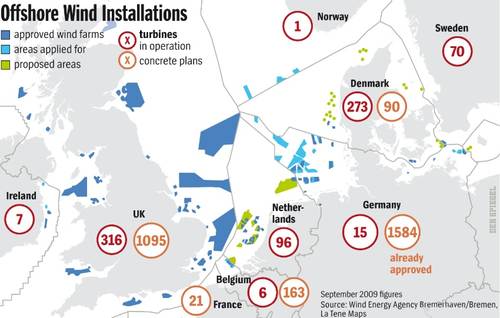This one passed under my radar in January, but has some potentially interesting implications for people working to minimize the negative effects of wind farms on wildlife and humans, in that the developer agreed to shut turbines down at night, at least temporarily. In December, a Federal court halted construction of the Beech Ridge wind farm in West Virginia, because Indiana Bats, officially listed Endangered Species, live nearby, and the developers had not obtained the necessary Incidental Take Permits that govern activities that may impact such species. In a settlement announced in January, Beech Ridge Energy, a subsidiary of Invenergy, agreed to forego construction of 24 turbines closest to the bat caves, while receiving approval to operate the 40 turbines that are already constructed, to complete construction of 27 more, and to move forward on planning for an additional 33 units (though the units not yet constructed may not begin operating until the ITP is received).
Most strikingly, the company agreed that all operational turbines will be shut down at night from April to November 15, when the bats are out and about. During the hibernation season, from mid-November through March, the turbines can operate around the clock. Future operating conditions, including the need for night-time curtailments, will be subject to the determination of the US Fish and Wildlife Service Incidental Take Permits. Noise is not the issue here, but rather bat mortality near wind turbines, likely caused by rapid changes in air pressure.
It is encouraging to see the viability of operational restrictions being experimented with, and accepted by both industry and environmental groups as a way forward through a contentious issue. Indiana Bats are not known to travel in the area of the wind farm, though the proximity of their caves suggests they may; monitoring done by the company was challenged in the lawsuit as insufficient. Ongoing acoustic surveys will help clarify how common they are, and the USFWS may decide that night time restrictions are unnecessary. As part of this settlement, the company agreed not to appeal the judge’s decision, and the environmental plaintiffs agreed not to appeal the eventual ITP decision by USFWS.
Happy talk all around after the agreement: Dave Burhman, spokesman for MCRE, said, “We believe our actions have sent a vitally needed message to the wind industry as a whole. Renewable energy projects do not get a pass on existing laws designed to protect endangered species and the natural environment. And although industrial wind turbines will now spin atop some of Greenbrier County’s highest ridges, they will forever be banned on those ridges in closest proximity to endangered Indiana bat caves.” And Joe Condo, general counsel for the company, agreed that “We are very pleased to have reached an agreement that allows us to move forward with creating clean, renewable energy in Greenbrier County while at the same time meeting the goals of important wildlife conservation efforts.
Sources:
Beckley Register-Herald, 1/27/10
West Virginia Highlands Conservancy, 2/10/10


